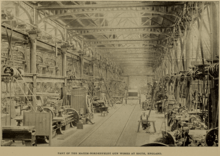Maxim Nordenfelt Guns and Ammunition Company
The Maxim-Nordenfelt Guns and Ammunition Company was the result of a takeover by Hiram Maxim of Thorsten Nordenfelt's Nordenfelt Guns and Ammunition Company in 1888. Rothschild issued £1.9 million of shares to finance the merger. Nathan Rothschild retained a substantial shareholding in the new Maxim-Nordenfelt combine and ‘exerted a direct influence over its management’.[1]
| Industry | Armaments |
|---|---|
| Fate | Acquired |
| Successor | Vickers, Sons and Maxim |
| Founded | 1888 |
| Defunct | 1897 |
| Headquarters | 32 Victoria Street SW, London, UK |
| Products | Machine guns Artillery Ammunition |

History
The company produced a range of light artillery, machine guns and ammunition.[2]
It was the subject of one of history's most famous court cases in 1894, Nordenfelt v Maxim, Nordenfelt Guns and Ammunition Co, in which Nordenfelt successfully claimed that the takeover condition preventing him from competing with Maxim for 25 years "in any way" was an unreasonable restraint of trade, but failed to overturn the main condition preventing Nordenfelt from competing with Maxim in the guns and ammunition trade for 25 years.[3]
The company competed against the Armstrong subsidiary Elswick Ordnance Company's range of armaments, which included Hotchkiss guns made under licence.
The company became part of the Barrow Shipbuilding Company, which was taken over by Vickers, Sons and Company in 1897 to form Vickers, Sons & Maxim. This gave Vickers a complete naval shipbuilding, engineering and armaments capability, an advantage Armstrongs had held for many years, and eventually allowed Vickers to take over Armstrongs.[4][5]
During the Second Boer War, the British used Maxim machine guns, and the Boers used a modified Maxim, a belt-fed, water-cooled machine gun that fired explosive one-pound rounds (smokeless ammunition) at 450 rounds per minute; it became known as the "Pom Pom".[6]
See also
References
- Niall Ferguson, House of Rothschild, The World’s Bankers, 1819-1999, vol. 2. p. 413.
- John Ellis (1975). The Social History of the Machine Gun. Baltimore, Maryland: The Johns Hopkins University Press. p. 37. ISBN 0-8018-3358-2.
- Coordination and Information: Historical Perspectives on the Organization of Enterprise. Chicago - London: The University of Chicago Press. 1995. p. 187. ISBN 0-226-46820-8.
- Ruth Mansergh (2015). Barrow-in-Furness in the Great War. Barnsley, South Yorkshire: Pen and Sword Ltd. p. 11. ISBN 978-1-78383-111-1.
- Ian Buxton, Ian Johnston (2013). The Battleship Builders Constructing and Arming British Capital Ships. Barnsley, South Yorkshire: Seaforth Publishing. ISBN 978-1-47382-226-9.
- http://www.smallarmsreview.com/display.article.cfm?idarticles=2490, SOUTH AFRICA’S NATIONAL MUSEUM OF MILITARY HISTORY
External links
| Wikimedia Commons has media related to Maxim-Nordenfelt. |